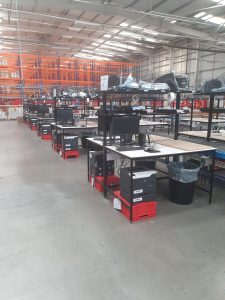Your basket is currently empty!

2018 - the year e-commerce changed the rules of fashion logistics
02/01/2019 by admin
Last year, the rapid increases of online orders really made fashion company’s rethink how they organise their warehouse logistics.
In the summer of 2018, workers at fashion retailer H&M’s Spanish logistics centre in Torrejón de Ardoz protested about their working conditions, which were affected by the increases in online orders. The 318 workers faced increasing pressure to keep up with more online orders. The H&M warehouse had been designed to dispatch orders to retail shops and not for individual online orders, but H&M took notice of its employees’ complaints. In October 2018, the firm announced it was building a new warehouse specially designed to support online orders.
Garment rail manufactures supply rails to traditional warehouses whose systems of picking and packing orders need redesigning because of online orders. To cope with demand, companies have introduced more automated systems. Robots can pick items, but these are expensive for small to medium companies. Instead, they use automated picking systems that direct human workers to the location of ordered items. Standard garment rails, combined with automated systems, are the solution for many small to medium fashion retailers looking to process high volumes of online orders.
Online fashion orders account for approximately 25% of all fashion sales, and this is expected to increase. Many clothing retailers, such as Joules and Crew Clothing, retain retail stores but have had to adapt to a boom in online orders. This has required either new warehouses or the complete redesign of existing ones.
You may also interested in:

How repairing damaged warehouse equipment beats replacing entirely
A White Paper by Southgate Global has detailed how repairing warehouse equipment instead of
Warehouse operators warned about energy compliance crisis
New energy regulations could render some warehouse space unusable by 2030 due to
